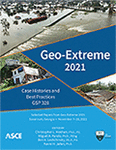A Preliminary Study on the Use of Differential Interferometric Synthetic Aperture Radar (DInSAR) for Ground Subsidence Assessment
Publication: Geo-Extreme 2021
ABSTRACT
Ground subsidence is a major engineering problem in urban areas where population growth and rapid urban development are taking place. Central Florida is also known as the karst area with its unique hydrogeological setting, posing potential ground instability such as sinkhole-induced subsidence and ground settlement due to urban construction and development. Monitoring of ground subsidence can help not only mitigate its negative impacts in many engineering ways but also enhance the related risk management. With recent advances in remote sensing technology, Interferometric Synthetic Aperture Radar (InSAR) can be a promising tool to measure and monitor ground subsidence. The goal of this study is to explore the feasibility of InSAR for the ground subsidence assessment. Particularly, we investigated the spatial distribution of ground subsidence in the Orlando metropolitan area and its near vicinities over two different times. For this, the Differential Interferometric Synthetic Aperture Radar (DInSAR) method was applied to develop a ground subsidence map between May 8, 2018, and May 9, 2020, using the European Space Agency (ESA) Sentinel-1 SAR images. The results show that the study area is clearly showing a cumulative ground movement trend of varying degrees, with −22.9 cm (subsidence) and +2.0 cm (uplift), over the past two years. It also shows that the magnitude of ground subsidence in this area was largely related to land use and development activities. This study demonstrates that the multitemporal InSAR processing technique is capable of high-precision monitoring of ground subsidence in urban areas for engineering purposes.
Get full access to this article
View all available purchase options and get full access to this chapter.
REFERENCES
Bouchra, A., Mustapha, H., and Mohammed, R. (2020). “D-InSAR Analysis of Sentinel-1 Data for Landslide Detection in Northern Morocco, Case Study: Chefchaouen.” Journal of Geoscience and Environment Protection, 8(7), 84–103.
Caló, F., Notti, D., Galve, J. P., Abdikan, S., Görüm, T., Pepe, A., and Balik Şanli, F. (2017). “DInSAR-Based Detection of Land Subsidence and Correlation with Groundwater Depletion in Konya Plain, Turkey.” Remote Sensing, 9(1), 83.
Crosetto, M., Monserrat, O., Cuevas-González, M., Devanthéry, N., and Crippa, B. (2016). “Persistent Scatterer Interferometry: A review.” ISPRS Journal of Photogrammetry and Remote Sensing, 115, 78–89.
European Space Agency. (2020). “Copernicus Open Access Hub.” Sentinel Data, <https://scihub.copernicus.eu/dhus/#/home>. (May 11, 2020).
European Space Agency. (2020). “Science Toolbox Exploitation Platform.” SNAP (Sentinel Applcation Platform), <https://step.esa.int/main/toolboxes/snap/>. (May 20, 2020).
European Space Agency. (2020). “Sentinel Missions.” Sentinel-1, <https://sentinel.esa.int/web/sentinel/missions/sentinel-1>. (June 24, 2020).
Ferretti, A., Monti-Guarnieri, A., Prati, C., and Rocca, F. (2007). “InSAR Principles: Guidelines for SAR Interferometry Processing and Interpretation ” TM-19, K. Fletcher, ed., European Space Agency, Netherlands 48.
Ferretti, A., Prati, C., and Rocca, F. (2000). “Nonlinear subsidence rate estimation using permanent scatterers in differential SAR interferometry.” IEEE Transactions on Geoscience and Remote Sensing, 38(5), 2202–2212.
Ferretti, A., Prati, C., and Rocca, F. (2001). “Permanent scatterers in SAR interferometry.” IEEE Transactions on Geoscience and Remote Sensing, 39(1), 8–20.
Florida Geological Survey. (2020). “Florida Subsidence Incident Reports.” Filtered Dataset: Shapefile, <https://geodata.dep.state.fl.us/datasets/194ac159bd1e4be294b14dd882d42dcf_0?geometry=-101.476%2C24.334%2C-64.935%2C31.134>. (May 20, 2020).
Fornaro, G., Pauciullo, A., and Serafino, F. (2009). “Deformation monitoring over large areas with multipass differential SAR interferometry: a new approach based on the use of spatial differences.” International Journal of Remote Sensing, 30(6), 1455–1478.
Gabriel, A. K., Goldstein, R. M., and Zebker, H. A. (1989). “Mapping small elevation changes over large areas: Differential radar interferometry.” Journal of Geophysical Research: Solid Earth, 94(B7), 9183–9191.
Hooper, A., Zebker, H., Segall, P., and Kampes, B. (2004). “A new method for measuring deformation on volcanoes and other natural terrains using InSAR persistent scatterers.” Geophysical Research Letters, 31(23).
Kim, Y. J., and Nam, B. H. (2017). “Sinkhole Hazard Mapping Using Frequency Ratio and Logistic Regression Models for Central Florida.” Geo-Risk 2017, 246–256.
Kim, Y. J., Nam, B. H., Shamet, R., Soliman, M., and Youn, H. (2020). “Development of Sinkhole Susceptibility Map of East Central Florida.” Natural Hazards Review, 21(4), 04020035.
Kim, Y. J., Nam, B. H., and Youn, H. (2019). “Sinkhole Detection and Characterization Using LiDAR-Derived DEM with Logistic Regression.” Remote Sensing, 11(13), 1592.
Li, P., Shi, C., Li, Z., Muller, J.-P., Drummond, J., Li, X., Li, T., Li, Y., and Liu, J. (2013). “Evaluation of ASTER GDEM using GPS benchmarks and SRTM in China.” International Journal of Remote Sensing, 34(5), 1744–1771.
Meziane, S., Bahi, L., and Ouadif, L. (2018). “Differential Synthetic Aperture Radar Interferometry for Land Movements Mapping Case of El Jebha (North of Morocco).” International Journal of Civil Engineering and Technology, 9(5), 105–113.
Radutu, A., Nedelcu, I., and Gogu, C. R. (2017). “An overview of ground surface displacements generated by groundwater dynamics, revealed by InSAR techniques.” Procedia Engineering, 209, 119–126.
Rajabi, A., Kim, Y., Kim, S.-H., Kim, Y., Kim, B., and Nam, B. H. (2018). “A Preliminary Study on Use of LiDAR Data to Characterize Sinkholes in Central Florida.” IFCEE 2018, 23–31.
Shirzaei, M., Bürgmann, R., and Fielding, E. J. (2017). “Applicability of Sentinel-1 Terrain Observation by Progressive Scans multitemporal interferometry for monitoring slow ground motions in the San Francisco Bay Area.” Geophysical Research Letters, 44(6), 2733–2742.
Wempen, J. M. (2020). “Application of DInSAR for short period monitoring of initial subsidence due to longwall mining in the mountain west United States.” International Journal of Mining Science and Technology, 30(1), 33–37.
Information & Authors
Information
Published In
Copyright
© 2021 American Society of Civil Engineers.
History
Published online: Nov 4, 2021
Authors
Metrics & Citations
Metrics
Citations
Download citation
If you have the appropriate software installed, you can download article citation data to the citation manager of your choice. Simply select your manager software from the list below and click Download.
